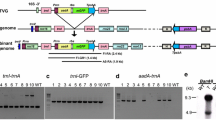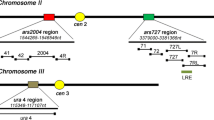Summary
Six kinds of autonomously replicating sequences (ARSs) derived from Drosophila or tobacco were inserted into the vector pDSV, constructed with pSV2-gpt and the copia long terminal repeat (LTR). The resulting ARS-containing plasmids, pDSV-ARSs, were transfected into the cultured Drosophila cells of GM1 S1cl1. Most of the plasmids remained for about 2 weeks and some for about 1 month in these cells. The retention time of the plasmid was not directly correlated with autonomously replicating activity of ARSs detected in the yeast. Two plasmids, one carrying ARS of Drosophila nuclear DNA and the other carrying tobacco DNA, showed the longest retention time in transformed cells and replication was confirmed in these cells. Some of these long lived plasmids were recovered, however, as modified forms. Other plasmids had disappeared 1 month after transfection. Two months following transfection, none of plasmids were recovered but they were detected in nuclear DNA as the integrated form. The integration patterns in all the cells transformed by different kinds of ARS-containing plasmids were similar to each other, and to the distribution pattern of copia LTR in the genome. These results suggest that copia LTR sequences contained in the pDSV-ARSs may participate in the integration process of these plasmids into Drosophila DNA.
Similar content being viewed by others
References
Broach JR, Hicks JB (1980) Replication and recombination function associated with the yeast plasmid, 2 μ circle. Cell 21:501–508
Cross DT, Sang JH (1978) Cell culture of individual Drosophila embryos. I. Development of wild-type cultures. J Embryol Exp Morphol 45:161–172
Flavell AJ, Levis R, Simon MA, Rubin GM (1981) The 5′ termini of RNAs encoded by the transposable element copia. Nucleic Acids Res 9:6279–6291
Ito H, Fukuda Y, Murata K, Kimura A (1983) Transformation of intact yeast cells treated with alkali cations. J Bacteriol 153:163–168
Kearsey S (1984) Structure requirements for the function of a yeast chromosomal replicator. Cell 37:299–307
Kiss GB, Amin AA, Pearlman RE (1981) Two separate regions of the extrachromosomal ribosomal DNA of Tetrahymena thermophila enable autonomous replication of plasmids in Saccharomyces cerevisiae. Mol Cell Biol 1:535–543
Maniatis T, Fritsch EF, Sambrook J (1982) In: Molecular cloning. Cold Spring Harbor Laboratory Press, Cold Spring Harbor, New York
Marunouchi T, Hosoya H (1984) Isolation of an autonomously replicating sequence (ARS) from satellite DNA of Drosophila melanogaster. Mol Gen Genet 196:258–265
Marunouchi T, Matsumoto Y, Hosoya H, Okabayashi K (1987) In addition to the ARS core, the ARS box is necessary for autonomously replicating sequences. Mol Gen Genet 206:60–65
Nakajima S, Miyake T (1978) Cell fusion between temperature-sensitive mutants of a Drosophila melanogaster cell line. Somatic Cell Genet 4:131–141
Rio DC, Rubin GM (1985) Transformation of cultured Drosophila melanogaster cells with a dominant selectable marker. Mol Cell Biol 5:1833–1838
Scherer G, Tschidi C, Perera J, Delius H (1982) B104, a new dispersed repeated gene family in Drosophila melanogaster and its analogies with retroviruses. J Mol Biol 157:435–451
Sinclair JH, Sang JH, Bruke JF, Ish-Horowicz D (1983) Extrachromosomal replication of Copia-based vectors in cultured Drosophila cells. Nature 306:198–200
Stinchcomb DH, Thomas M, Kelly J, Selker E, Davis RW (1980) Eukaryotic DNA segments capable of autonomous replication in yeast. Proc Natl Acad Sci USA 77:2651–2655
Tschumper G, Carbon J (1980) Sequence of a yeast DNA fragment containing a chromosomal replicator and the TRP1 gene. Gene 10:157–166
Uchimiya H, Ohtani T, Ohgawara T, Sugita M, Sugiura M (1983) Molecular cloning of tobacco chromosomal and chloroplast DNA segments capable of replication in yeast. Mol Gen Genet 192:1–4
Wigler M, Silverman S, Lee L-S, Pellicer A, Young YC, Axel R (1977) Transfer of purified herpes virus thymidine kinase to cultured mouse cells. Cell 11:223–231
Zakian VA, Kupfer DM (1982) Replication and segregation of an unstable plasmid in yeast. Plasmid 8:15–28
Author information
Authors and Affiliations
Additional information
Communicated by B.H. Judd
Rights and permissions
About this article
Cite this article
Kurata, N., Marunouchi, T. Retention of autonomous replicating plasmids in cultured Drosophila cells. Mol Gen Genet 213, 359–363 (1988). https://doi.org/10.1007/BF00339603
Received:
Issue Date:
DOI: https://doi.org/10.1007/BF00339603




